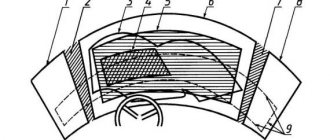What are airbags?
Airbags are elastic fabrics or other materials that are tightly packed in different areas of your vehicle. Most cars have airbags on the front dashboard, and many cars have airbags along the side of the car. These bags are compressed and stored in a small area. When an accident occurs , they provide a cushioning system for the people in the car to help prevent them from being thrown out in the event of an accident. While it won't always save you from serious injury or death, there are many situations where occupant cushioning can make a lot of sense.
The first Airbag design was patented in 1951, but the auto industry was slow to adopt the technology until the 70s.
Airbags and seat belts work together
Some drivers with limited knowledge of car safety believe that if a car has airbags, then they protect well enough and there is no need to use seat belts. The “smartest” ones try to deceive the seat belt sensor, pass the seat belt behind their back and fasten it into the buckle. This should not be done.
Airbags are designed to be used in conjunction with seat belts .
For example, if a passenger who is not wearing a seat belt gets into an accident, he will continue to move forward by inertia. And the “saving” airbag will open towards him at a speed of about 200 km/h. In this case, the passenger may be seriously injured.
So remember. Seat belts also provide protection in cars without airbags. But the pillows only work in conjunction with the belts.
How do they work?
- Each individual airbag is inflated and packaged in a compartment located in the dashboard, steering wheel, seat or other location.
- The front Airbag includes a large nylon bag that inflates and deflates quickly in the event of a serious frontal collision.
- Airbag deployment is monitored by sensors that detect the occurrence and severity of an accident. When the controller determines that the Airbag needs to be deployed, the system starts the inflator unit, which in turn burns chemicals that produce a lot of inert gas to inflate the bag.
- When the bag inflates, it rips open the covers on the dashboard, floating in front of the passenger. At the same time, the head and upper part of the passenger move with considerable force towards the inflated bag. When the occupant's head comes into contact with the airbag, it begins to deflate through the vents in the base. This softens the forward movement of the head. The entire process happens in the blink of an eye, in about 100 milliseconds.
- There will be a lot of smoke, dust and noise during deployment, and the passenger may not be aware that the airbag has deployed. This is fine.
Collision sensors
The most important parts of a successful airbag system are the crash sensors. These small pieces of electronics are designed to let you know when your car is damaged in an accident. They respond to several different sets of stimuli, including sudden stopping and increased pressure (when pieces of the car move due to the force of the collision), etc.
The airbag sensors, located at the front of the cabin, are controlled by various types of sensors that measure:
- wheel speed
- passenger's condition
- brake pressure and impact
- and other car status indicators
The sensors transmit signals to the airbag control unit, which analyzes the data and can control safety functions such as:
- seat belt lock
- automatic door locks
- airbag deployment.
There are two types of sensors used in a car - electrical and mechanical.
Some use an electromechanical "ball and tube" mechanism, which basically consists of a small tube containing a circuit breaker and a ball held together by a small magnet. When the collision occurs, the ball is ejected from the magnet and rolls forward in the tube, pressing a switch that completes an electrical circuit.
Other electrical designs are similar in principle, using a metal roller or spring-loaded weights instead of a ball, or in newer cars an accelerometer to disable the sensor.
Mechanical sensors operate independently of the electrical system and respond similarly to electrical sensors, with a design that actuates a firing pin that triggers a small explosion after an accident.
Because a mechanical sensor does not require a power source, it cannot be disabled like an electrical sensor when the battery is disconnected.
The success of an airbag system depends on the crash sensors working not only accurately but also very quickly, which is why they are the most expensive and technologically advanced part of the airbag system.
General device
Conventionally, experts divide a pneumatic cushion into 3 components: a pressurization system (or gas generator), a bag and electronic shock sensors.
Bag
- This is a nylon shell, which is located in a specially designated tire, covered with a fabric or plastic lining. Despite the tiny thickness of the material (maximum 0.4 mm), the bag is able to withstand colossal loads with the condition that they will be short-lived.
Gas generator
consists of two capsules (squibs) responsible for supplying gas to the bag. Why are two capsules used and not one? The fact is that if there is only a single squib, it is quite difficult to regulate how much gas enters the airbag. Therefore, the principle of operation of an airbag in its modern form is as follows: when activated, one squib releases 80% of the gas, and the second is activated only in the event of a severe collision, when a person needs a more rigid safety element.
Shock sensors.
They are usually located at the front of the car. These active safety components must respond immediately if the vehicle collides with another object at speeds above 20 km/h. Moreover, it is the sensors that read the impact force and transmit an activation signal to one or two squibs. Accordingly, even if the car is stationary and another vehicle crashes into it, the airbag will still do its job. In short, the sensors react even before the airbag deploys,
In addition to the main impact sensors, the protection system includes sensors for the passenger seat, which prevent activation of the airbags if there is no one in the cabin besides the driver. In addition, sometimes accelerometers are additionally installed - devices that allow you to determine the position of the vehicle. However, in any case, all 3 main components of a car’s active safety must be in good working order - only then can they work flawlessly.
When do airbags deploy?
For the driver or passenger airbag to deploy, the following minimum requirements must be met:
- The car must travel at a speed of more than 25 km/h.
- The impact angle is approximately thirty degrees on either side of the vehicle's centerline (about 60 degrees total).
- The deceleration force is at least equal to that which occurs when a car collides with a stationary barrier at a speed of about 25 km/h.
Note: Front airbags will not deploy in a side, rear or rollover collision as they do not provide additional protection.
Sensor location
So where are the airbag crash sensors located? It all depends on the model of a particular car. The most common examples of controller layouts are here:
- Airbag control device.
- Inside the salon.
- In some cases, in the engine compartment of a car.
Where are the airbag crash sensors located? In the case of foreign cars, there is another additional shock sensor - this is to turn off the fuel pump. It often causes problems - in the event of a minor impact, the airbags do not deploy, but at the same time, the car cannot be started until this sensor is activated.
Other types of airbags
Dual-stage airbags are a smarter generation of airbags that optimize the level of airbag deployment according to the severity of the crash.
Side and curtain airbags help protect occupants from head, neck and chest injuries during side impacts and rollovers.
Knee pads protect the lower extremities from injuries caused by impacts with the instrument panel.
Is it possible to install additional airbags in a car?
Sometimes drivers have questions about installing additional airbags in a car.
For example, when buying a car there was not enough money for additional pillows. After a couple of years, the money appeared and the driver wanted to improve the safety level of the vehicle.
Theoretically, it is possible to install additional pillows, but in practice it is not economically feasible. And it’s unlikely that anyone will take on this job.
It is cheaper to purchase a similar car with additional airbags than to try to “shove” airbags, sensors and new control units into your car.
So we will assume that it is impossible to install additional airbags in a car .
Emerging problems
Front airbags are designed to protect people from adults. Since children are smaller, they are at risk of injury from its operation. Therefore, they should not occupy the front seat if the car has an Airbag for the passenger.
The car should not have accessories installed that could limit the deployment of the Airbag or become a missile when it is deployed.
Airbag systems usually have a warning light with an indicator. If the lamp does not go out immediately after starting or comes on while driving, check the owner's manual and have it checked by a workshop. The system has detected an error.
If you don't do this, the airbags may unexpectedly deploy during repairs, especially during electrical work. This can cause serious injury, so leave repairs to qualified personnel.
The airbags deploy with explosive force and are far from the big fluffy airbags some people might imagine. It is not uncommon for minor injuries and abrasions to remain from contact with the pillow.
Several vehicle manufacturers determine the lifespan of airbag components. Usually the airbag warning light comes on and components must be replaced before it goes off.
Shock sensors
Shock sensors are elements on which the operation of the entire system depends. They are the ones who determine that a collision has occurred, which is why the airbags are deployed. At first, only front sensors were used. Previously, the number of airbags was not large and their task was to increase injury safety in frontal collisions. Nowadays, many cars are equipped with side devices, which is why the number of sensors has increased.
Example location of SRS system impact sensors
The entire system is designed in such a way that in the event of an accident, only the necessary airbags are deployed, and not all at once. And for this it is necessary to determine the force of the blow, its direction, and character. This is ensured by sensors installed in different parts of the body - in the front part, doors, pillars.
Electromechanical type sensors are considered traditional. They are quite simple in design, but at the same time quite effective. The main elements of such a sensor are a ball and a spring of a certain stiffness. It works like this: upon impact, inertia forces the ball to move, overcoming the force of the spring, as a result the contacts close and the impulse from the sensor goes to the control unit.
Electromechanical view of a sensor with a ribbon spring
It is worth noting that the spring stiffness is significant. This eliminates false alarms of the system, for example, during emergency braking or a slight impact with an obstacle. So, in the event of a collision while driving at low speed (up to 20 km/h), the airbag will not work, since the inertial force will simply not be enough to overcome the spring force.
In addition to electromechanical sensors, cars also use electronic types, the main element of which is an acceleration sensor (capacitor, inertial, pressure). The design of the electronic elements also includes a signal processing unit from the acceleration sensor.
Inertial sensor device
The principle of operation of a capacitor acceleration sensor is reduced to a change in capacitance due to the displacement of the plates. And this is achieved by separating the capacitor plates and fixing them on different bases, one of which is fixed, the second is movable. Upon impact, the same inertial force displaces the movable base with the plates relative to the stationary one. As a result, the capacitance of the capacitor sensor changes. This records the processing unit, compares the received data with the table data and, based on this, generates a signal to the control unit.
Capacitor acceleration sensor
Other types of sensors also work on this principle; the only difference comes down to their design. All of them, due to inertia, change some parameters, which is the basis for the signal generation by the processing unit.
Note that the shock sensors are configured based on their installation location. Thus, the side elements are usually more sensitive than the front ones.
To detect an impact, sensors can be installed in the door area that record changes in atmospheric pressure in the car doors. They are either piezoelectric or capacitive. The first type is based on the piezoelectric effect, and the second on the principle of a capacitor sensor.
Shock sensors recording pressure changes
The response speed of each type of sensor is also taken into account, so several types can be installed in a car at the same time. For example, pressure sensors are characterized by high performance, so they are often installed on the sides (in doors, pillars).
The main advantage of electronic sensors is to determine the nature of the impact - force, direction. This is achieved due to tabular data embedded in the processing unit.
Switching off the airbags
Airbags are designed so that they do not need to be turned on, but can sometimes be turned off. This is due to safety reasons as there are cases where they can cause more harm than good.
When a vehicle includes the ability to deactivate the passenger airbags, the deactivation mechanism is usually located on the passenger side of the dashboard.
The procedure for removing the driver's side Airbag is usually more complicated, and if done incorrectly, it can cause the airbag to deploy. If you are concerned that the driver's side airbag may harm you, you should contact a professional to disable it.
Did you like the article? Share on social media networks:










